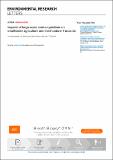Impacts of large-scale land acquisitions on smallholder agriculture and livelihoods in Tanzania

View/
Date
2022-07-27Author
Sullivan, Jonathan
Brown, Dan
Moyo, Francis
Jain, Meha
Agrawal, Arun
Metadata
Show full item recordAbstract
Improving agricultural productivity is a foundational sustainability challenge in the 21st century.
Large-scale land acquisitions (LSLAs) have important effects on both well-being and the
environment in the Global South. Their impacts on agricultural productivity and subsequent
effects on farm incomes, food-security and the distribution of these outcomes across households
remain under-investigated. In particular, prior studies do not sufficiently attend to the mechanistic
nature of changes in household agricultural practices that affect LSLA outcomes. To address these
challenges, we use a novel household dataset and a quasi-experimental design to estimate
household-level changes in agricultural productivity and other LSLA outcomes in Tanzania. We
use causal mediation analysis to assess how four common mechanisms—contract farming, land
loss, market access and technology adoption around LSLAs—influence agricultural productivity.
We find that households near LSLAs exhibit 20.2% (95% CI: 3.1%–37.3%) higher agricultural
productivity, primarily due to increased crop prices and farmer selection of high-value crops.
Importantly, the direction and magnitude of effect sizes associated with the different mechanisms
vary. The presence of contract farming explains 18.1% (95% CI: 0.56%, 47%) of the effect size in
agricultural productivity, whereas land loss reduces agricultural productivity by 26.8% (95% CI:
−71.3%, −4.0%). Market access and technology adoption explain little to no portion of the effect
size on agricultural productivity. Despite higher agricultural productivity mediated by contract
farming, we do not find increased household incomes or food security. Plausible explanations
include limited market access, higher crop prices restricting food access and elite capture of
contract farming concentrating income effects to a few households. Our results stand in contrast to
assumptions that technological spillovers occur through LSLAs and are the principal drivers of
LSLA-induced agricultural transformation. We find instead that access to contract farming and
high-value crops lead to greater agricultural productivity, but also that benefits related to these
mechanisms are unequally distributed.
